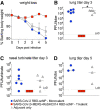This is a preprint.
Vaccine-mediated protection against merbecovirus and sarbecovirus challenge in mice
- PMID: 37293083
- PMCID: PMC10245799
- DOI: 10.1101/2023.05.22.540829
Vaccine-mediated protection against merbecovirus and sarbecovirus challenge in mice
Update in
-
Vaccine-mediated protection against Merbecovirus and Sarbecovirus challenge in mice.Cell Rep. 2023 Oct 31;42(10):113248. doi: 10.1016/j.celrep.2023.113248. Epub 2023 Oct 18. Cell Rep. 2023. PMID: 37858337 Free PMC article.
Abstract
The emergence of three distinct highly pathogenic human coronaviruses - SARS-CoV in 2003, MERS-CoV in 2012, and SARS-CoV-2 in 2019 - underlines the need to develop broadly active vaccines against the Merbecovirus and Sarbecovirus betacoronavirus subgenera. While SARS-CoV-2 vaccines are highly protective against severe COVID-19 disease, they do not protect against other sarbecoviruses or merbecoviruses. Here, we vaccinate mice with a trivalent sortase-conjugate nanoparticle (scNP) vaccine containing the SARS-CoV-2, RsSHC014, and MERS-CoV receptor binding domains (RBDs), which elicited live-virus neutralizing antibody responses and broad protection. Specifically, a monovalent SARS-CoV-2 RBD scNP vaccine only protected against sarbecovirus challenge, whereas the trivalent RBD scNP vaccine protected against both merbecovirus and sarbecovirus challenge in highly pathogenic and lethal mouse models. Moreover, the trivalent RBD scNP elicited serum neutralizing antibodies against SARS-CoV, MERS-CoV and SARS-CoV-2 BA.1 live viruses. Our findings show that a trivalent RBD nanoparticle vaccine displaying merbecovirus and sarbecovirus immunogens elicits immunity that broadly protects mice against disease. This study demonstrates proof-of-concept for a single pan-betacoronavirus vaccine to protect against three highly pathogenic human coronaviruses spanning two betacoronavirus subgenera.
Keywords: MERS-CoV; SARS-CoV; SARS-CoV-2; bat coronavirus; nanoparticle; neutralization; receptor binding domain; universal vaccine.
Conflict of interest statement
Competing interests: B.F.H. and K.O.S. have filed US patents regarding the nanoparticle vaccine. R.S.B. is on the scientific advisory boards of VaxArt, Invivyd, and Takeda.
Figures





References
-
- Gorbalenya A.E., Baker S.C., Baric R.S., de Groot R.J., Drosten C., Gulyaeva A.A., Haagmans B.L., Lauber C., Leontovich A.M., Neuman B.W., et al. (2020). The species Severe acute respiratory syndrome-related coronavirus: classifying 2019-nCoV and naming it SARS-CoV-2. Nature Microbiology 5, 536–544. 10.1038/s41564-020-0695-z. - DOI - PMC - PubMed
-
- Cohen A.A., Gnanapragasam P.N.P., Lee Y.E., Hoffman P.R., Ou S., Kakutani L.M., Keeffe J.R., Wu H.-J., Howarth M., West A.P., et al. (2021). Mosaic nanoparticles elicit cross-reactive immune responses to zoonotic coronaviruses in mice. Science, eabf6840. 10.1126/science.abf6840. - DOI - PMC - PubMed
Publication types
Grants and funding
LinkOut - more resources
Full Text Sources
Miscellaneous
